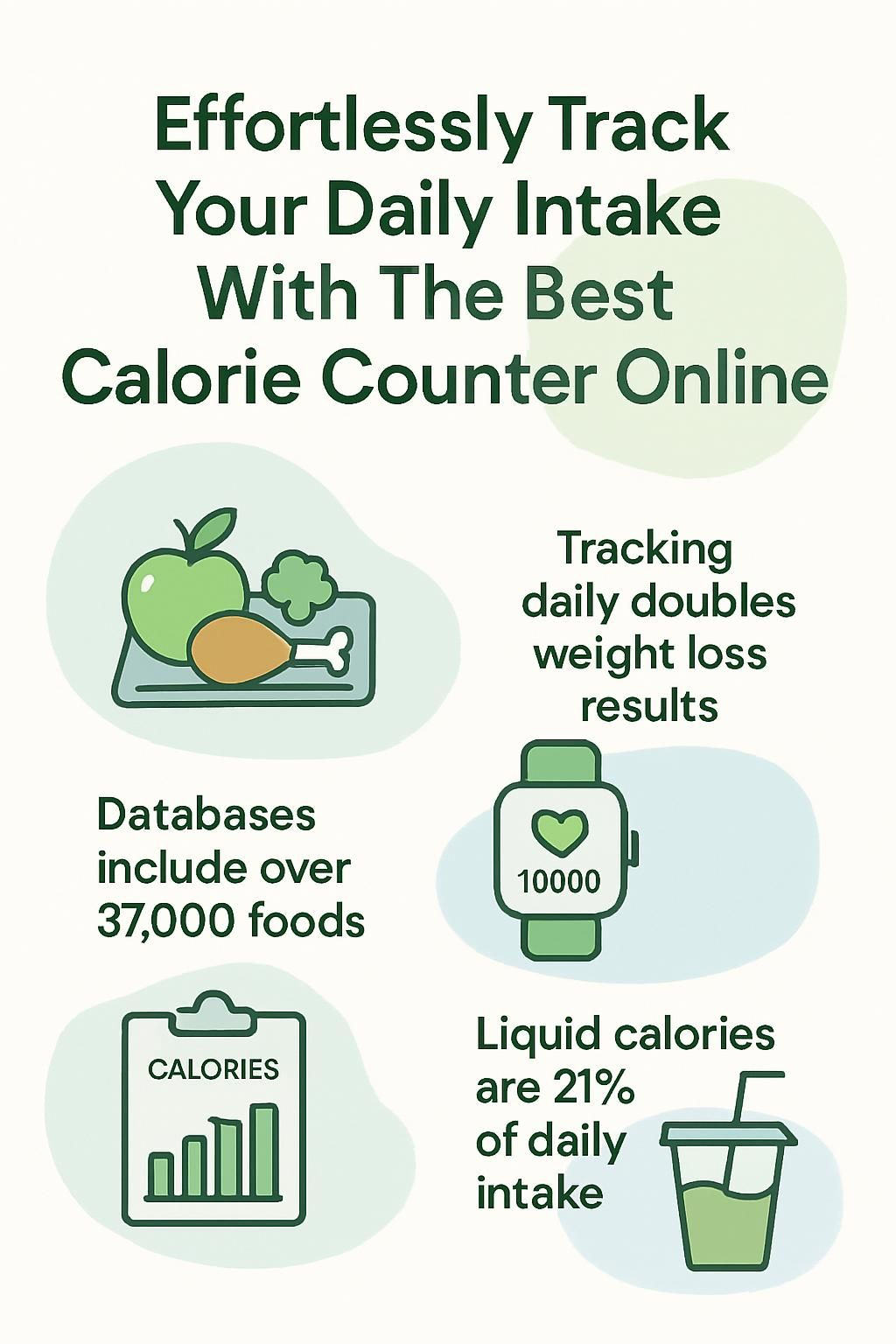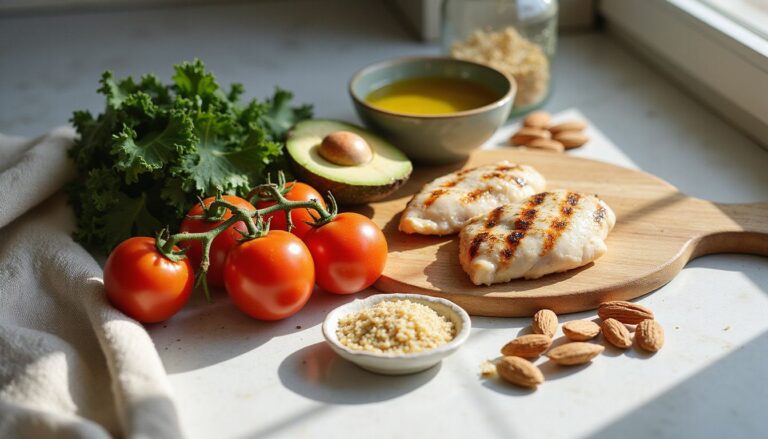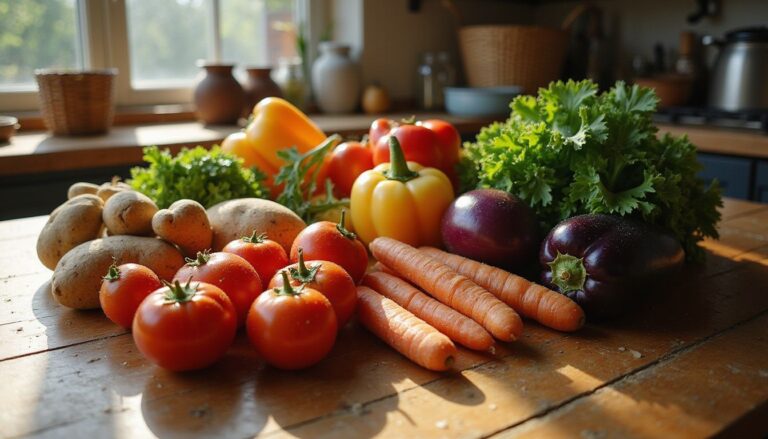Effortlessly Track Your Daily Intake With The Best Calorie Counter Online
Our Nutrition Assistant AI Suite will transform your body. You will lose fat, get toned, and build muscle. Gain confidence and optimal health.
Keeping track of how much you eat can feel confusing. A calorie counter makes it simple by showing what is in your food and how it fits your day. Research shows that steady logging improves awareness and supports weight management.
This guide explains how to use a calorie calculator, choose a nutrition tracking app, and set targets you can follow. You will see clear steps that help you meet your calorie needs and move toward your goal weight.
Key Takeaways
- Leading calorie counters such as MyFitnessPal and Cronometer include large food databases, barcode scanning, and sync with wearables for quick meal and exercise logging.
- Daily food diaries work. Studies cited by the National Institutes of Health show consistent trackers lose about twice as much weight as those who log less often.
- Apps estimate needs with equations like Mifflin-St Jeor. Safe minimums are about 1,200 calories for women and 1,500 for men, based on Harvard Health guidance.
- Good tools show full nutrition facts, including macros and micronutrients, so you can prevent gaps while adjusting intake for weight changes.
- Drinks can add many calories. Liquid calories account for about 21 percent of U.S. intake, so include beverages for accuracy.

Why Should You Use an Online Calorie Counter?

An online calorie counter tracks your daily intake and highlights patterns you might miss. It turns rough guesses into clear numbers, which helps you make steady, healthy changes.
How Does an Online Calorie Counter Simplify Tracking?
Barcode scanning and fast search features cut logging time. You can find a brand or a restaurant item in seconds and add it to your food diary. For example, logging a slice of pizza at 285 calories or a banana at 151 calories takes only a few taps.
The app displays nutrition facts for each item, including calories, protein, fat, carbohydrate, fiber, and sugar. Some tools let you follow sample meal plans such as 1,200, 1,500, or 2,000 calories per day. Recipe tools make low-calorie swaps easier without math.
Scanning a barcode at the store has helped me see if an item fits my macro goals. Tracking felt simple, and it supported my weight loss plan.
I learned the value of tracking after seeing a simple apple (59 calories) add up with other snacks. Using the app, I could spot exactly where hidden calories came from and adjust my eating habits.
How Can It Improve Awareness of Your Nutritional Habits?
Calorie counters turn your eating habits into clear data. You can see which foods give steady energy and which ones raise calories without many nutrients.
Liquid calories, like soda or juice, can reach 21 percent of daily intake and often add little nutrition. Food databases show a full breakdown, including dietary fiber and key vitamins and minerals. That makes choices easier.
Meal logs reveal patterns such as late-night snacking or frequent treats. Side-by-side serving comparisons teach portion control. For example, 500 calories of carrots adds more fiber than the same calories from popcorn with less nutrient value.
Logging water beside food entries supports smart choices instead of just cutting calories to lose 1 pound per week. Real-time feedback replaces guesswork from a nutrition facts label.
How Does It Support Weight Management Goals?
Once you understand your habits, you can set targets with confidence. Many apps use the Mifflin-St Jeor equation or a BMI calculator to estimate daily energy expenditure. Reducing average intake by about 500 calories per day can help you lose about 1 pound per week.
A food diary shows how your meals align with your goals and activity level. Macro tracking helps balance protein, fat, and carbohydrate for better metabolic support during calorie restriction. Medical guidance suggests a minimum of about 1,200 calories for women and 1,500 for men unless supervised by a clinician. This protects muscle and reduces risks from extreme dieting.
Important Features to Consider in a Calorie Counter
The best tools help you meet nutritional needs and track progress with minimal effort. Many also sync with exercise apps and devices like Fitbit or Apple Watch.
What Is a Comprehensive Food Database?
A comprehensive food database lists many foods, drinks, restaurant items, and branded products. Some counters include more than 37,000 items and pull from sources like the USDA and ESHA databases.
For better accuracy, search by brand or restaurant name. Each entry shows calories, fat, protein, carbohydrates, fiber, and sugar. Barcode scanning speeds up logging and reduces typing errors.
You can save time tracking your meals by scanning barcodes at the grocery store. Turning a long entry into a two-second scan makes daily logging easier to maintain.
With reliable data, you can manage food energy to maintain your current weight or reach a healthy weight goal.
How Do Customizable Goals and Recommendations Work?
After you explore the database, set your personal targets. Enter your age, gender, height, weight, and activity level. Choose units you prefer, either U.S. or metric.
Most apps offer five activity levels: sedentary, lightly active, moderately active, very active, and extra active. You can aim to lose or gain 1 pound per week by changing intake by about 500 calories per day. Some tools support zigzag calorie cycling, which varies daily calories by about 200 to 300, to promote sustainable loss while supporting metabolism.
Your recommended calories appear in calories or kilojoules. Many apps also estimate basal metabolic rate using the Harris–Benedict or Mifflin-St Jeor equations. That helps you match intake to your current fitness and body mass goals.
Why Track Macro and Micronutrients?
Calories matter, but the mix matters too. Macronutrients are carbohydrates, proteins, and fats. Micronutrients are vitamins and minerals your body needs in small amounts. Apps show both, so you see where your diet is strong or weak.
Fat has about 9 calories per gram. Protein and carbohydrates have about 4 per gram. Fiber contributes fewer calories and supports digestion. Tracking reveals empty calories quickly, especially from sugary drinks, which often lack key nutrients.
I once thought eating less was enough. Comparing foods in my tracker showed I leaned on nutrient-poor choices. Shifting to whole foods improved my energy and results.
Watching these details helps you avoid gaps while losing up to 2 pounds per week, or while adjusting intake to gain or maintain weight.
How Does Barcode Scanning Make Input Easier?
Barcode scanning speeds up logging. Point your camera at a package, and the app pulls in the full nutrition label.
Calories, macros, sugar, and more appear right away. Studies show scanning can cut entry time in half compared with typing. This is helpful if you eat packaged snacks or quick meals after school or work.
Scanning also improves accuracy because entries come from verified databases. If your goal is to lose about 1 pound a week, quick, accurate logging makes staying on target easier.
What Are the Benefits of Integration with Fitness Trackers?
Syncing a fitness tracker lets the app adjust your daily calorie goal based on activity. For example, walking for an hour may burn roughly 215 to 319 calories. Running can burn up to 923 calories per hour depending on your weight.
Seeing intake and burn side by side helps you plan meals. It also helps you decide whether to subtract 500 calories per day for loss, or add calories to gain weight safely.
After I linked my watch, my runs appeared in the app within minutes. On swim days, seeing an extra 600 calories burned helped me plan a larger dinner without stressing progress.
Top 5 Calorie Counters to Try in 2025
Free and paid options can support your nutrition goals. Choose a tool that fits your habits, tech comfort, and budget.
MyFitnessPal
MyFitnessPal offers one of the largest food databases, which makes meal logging fast. Its barcode scanner speeds entry and supports homemade recipes with a builder tool. You can set daily goals and track both macro and micronutrient intake.
The app syncs with many wearables for automatic workout logging. Community forums provide support, tips, and recipe ideas. Trend charts make it easier to spot patterns and refine your plan.
Features & Benefits of MyFitnessPal
Track daily nutrition with fast access to calories, fat, carbs, protein, fiber, and sugar. Set custom goals based on age, weight, and activity level.
Use the barcode scanner for quick meal entry. The recipe builder shows how small ingredient changes alter nutrition. You can also log water and view weekly and monthly charts that highlight progress.
These features make it easier to stick with calorie tracking over time.
Pros & Cons of MyFitnessPal
Transitioning from features, review the key strengths and trade-offs below.
| Pros | Cons |
|---|---|
|
|
Cronometer
Cronometer focuses on accuracy and depth. It uses verified entries, which improves trust in the numbers you see. You can track macros along with a wide set of micronutrients.
Custom recipes and meal plans support many diets. Detailed reports show vitamin and mineral intake. During a recent check, I learned I met my vitamin C goal from food alone, so I skipped a supplement.
Dietitians often recommend Cronometer for users who want more than calorie counts. It highlights nutrient gaps you can fix through better food choices.
Features & Benefits of Cronometer
Cronometer tracks more than 60 micronutrients, which helps you go beyond basic calories. Reports make it easy to see where to adjust your plan.
It supports special diets and medical nutrition needs, such as tracking potassium for kidney concerns or vitamin B12 for plant-based eating. Barcode scanning and custom recipes help with precise logging.
The wide, verified database is useful for evidence-based nutrition tracking.
Pros & Cons of Cronometer
Here are the main advantages and considerations for Cronometer.
| Pros | Cons |
|---|---|
|
|
Lose It!
Lose It! offers a large database and a simple interface. Barcode scanning speeds up daily logging, and charts show your progress clearly.
Meal planning and recipe entry make homemade tracking easier. The barcode scanner recognized most items at my local store, which helped me stay consistent and aware of habits.
This straightforward approach supports steady, sustainable change.
Features & Benefits of Lose It!
Use Lose It! to track calories and macros for every food you log. Set custom targets for calories, carbs, fat, and protein.
Some wearables sync exercise data automatically. Seeing workouts next to meals provides clear feedback and motivation through easy charts and weekly trends.
Pros & Cons of Lose It!
Review the highlights and limitations to decide if it fits your needs.
| Pros | Cons |
|---|---|
|
|
MyPlate by Livestrong
MyPlate offers daily food plans and portion guidance based on balanced eating. You can track calories, macros, water, and workouts in one place.
A supportive community helps you share progress and get encouragement. During a week of testing, the daily plans made my targets easier to meet. Barcode scanning and helpful charts reduce guesswork and highlight trends.
Features & Benefits of MyPlate
Set personalized calorie goals and build custom meal plans. The barcode scanner speeds entry for packaged foods.
Recipe tools let you save favorites for reuse. Clear reports and badges keep you engaged as you reach milestones.
MyPlate’s layout and tools simplify daily intake tracking and progress reviews.
Pros & Cons of MyPlate
MyPlate gives you meal planning tools and active community groups, which can boost motivation and structure. During early 2024, I found it quick for planning workday lunches and logging them.
There are trade-offs. Ads in the free version can interrupt your flow. The database is smaller, so unusual dishes may require manual entry. If barcode scanning depth matters, consider options with larger databases.
Yazio
Yazio combines a food diary, calorie tracker, and nutrition analysis. You can set goals for weight loss, muscle gain, or maintenance and see clear daily charts.
The app supports meal plans and intermittent fasting. Real-time feedback helps you stick to your plan, even on busy days.
Features & Benefits of Yazio
Yazio tracks calories, macros like protein and carbs, and selected micronutrients. It supports several diet styles, including low carb and vegan.
If you practice intermittent fasting, a built-in timer and meal reminders help you stay on schedule. The database includes many common foods, which makes logging faster.
Daily dashboards provide useful, motivating feedback over time.
Pros & Cons of Yazio
Yazio’s clean design is easy to use. Personalized plans and fasting tools can strengthen your routine. During a busy semester, reminders and preset meals helped me stay on track without feeling overloaded.
Some features sit behind a paid tier. Regional databases may be limited, which can make local items harder to find. If you need deeper nutrition data or wide barcode coverage, this might affect your experience.
How Do Calorie Counters Estimate Your Daily Calorie Needs?
Calorie counters use science-based equations plus your details to estimate daily calories. Understanding the inputs helps you set realistic goals.
What Factors Affect Daily Calorie Needs?
Daily calorie needs change with age, weight, height, gender, and activity level. More activity usually means higher energy needs. Sedentary adults need fewer calories than people who exercise often or have active jobs.
Metabolism and health status also matter. Many men need about 2,000 to 3,000 calories per day. Many women need about 1,600 to 2,400. Harvard Health suggests safe minimums around 1,200 calories for women and 1,500 for men unless supervised by a clinician.
Activity Level Guidelines:
- Sedentary: little or no exercise
- Light: light exercise 1 to 3 days per week
- Moderate: moderate workouts 3 to 5 days per week
- Active: intense training several days per week or daily movement
- Very Active: hard workouts 6 or 7 days per week
- Extra Active: very intense training plus a physically demanding job
How Does the Mifflin-St Jeor Equation Work?
The Mifflin-St Jeor equation estimates basal metabolic rate, which is the calories your body uses at rest. Use kilograms for weight and centimeters for height.
Men: BMR = 10W + 6.25H − 5A + 5
Women: BMR = 10W + 6.25H − 5A − 161
Multiply BMR by an activity factor from 1.2 to 1.95 to estimate total daily needs. Many apps use this method because it is accurate and practical. Using it inside a calorie counter keeps targets specific to your body and routine.
How Can You Track Calories More Effectively?
Small, steady habits beat short bursts. Use simple rules you can follow every day.
Why Is Consistency Important When Logging Meals?
Logging every snack, drink, and meal improves accuracy. It reveals patterns, like late snacking or high-calorie weekends, that you may not notice.
NIH data shows daily trackers tend to lose about twice as much as occasional loggers. Consistent data makes it easier to compare intake to exercise and adjust as needed.
After two weeks of complete logs, I saw that “small” snacks added hundreds of calories. Clear data supports better choices with fewer setbacks.
When Should You Adjust Your Goals Based on Progress?
Flexibility keeps progress safe. If weight drops faster than 2 pounds per week, reduce the deficit to protect muscle and energy levels.
Hitting a plateau often means it is time to recalculate daily needs or try small changes, such as varying daily intake by 200 to 300 calories, called zigzag calorie cycling. Review progress weekly rather than daily, then update goals in your app.
If your activity, health, or schedule changes, refresh your targets. This supports steady, sustainable results.
Should You Track Water Intake Alongside Calories?
Tracking fluids provides a fuller picture. Drinks can supply about 21 percent of daily calories in the United States, often with few nutrients.
Choosing water, tea, or unsweetened coffee can reduce liquid calories and improve fullness. Many apps offer water logs and reminders, which makes hydration goals easier to hit.
What Are Common Misconceptions About Calorie Counting?
Clearing up myths can improve your results and reduce frustration.
Is Calorie Counting Only for Weight Loss?
Calorie counting helps with loss, maintenance, and healthy gain. People who want to build muscle also benefit from careful tracking, since a small calorie surplus and enough protein support growth.
If your goal is to maintain your current weight, tracking prevents surprises and keeps nutrition balanced. Many apps let you set macro and micronutrient targets, not just calories. During marathon training, I tracked protein and iron to match higher needs.
Are All Calories the Same Regardless of Source?
Different foods affect your body in different ways. Carbohydrates, proteins, fats, and alcohol digest differently and influence hunger and energy.
High-fiber foods like fruits and whole grains require more chewing and can help you feel full longer. Fat-rich items and fried foods add calories fast. Sugary drinks add energy with little nutrition.
Caffeine from coffee or tea may slightly raise energy use for a short time. Spicy foods can have a small effect too. Two 100-calorie snacks can feel very different in fullness and impact on your day.
What Additional Tools Can Complement Calorie Counters?
Smart devices can fill in the gaps. They add real-time activity and body data that improve planning.
How Do Fitness Trackers and Wearables Help?
Trackers log steps, heart rate, and workouts automatically. Most calorie counters import this data, which updates your daily calorie budget in real time.
Walking for an hour may burn about 215 to 319 calories. Swimming can reach 397 to 587. Running may range from 624 to 923 depending on weight.
When I moved from a desk job to an active role, my tracker showed extra calories burned by afternoon. Matching meals to that data made eating the right amount easier.
What Are Smart Scales and How Do They Work?
Smart scales measure more than weight. Many estimate body fat, muscle mass, and water content using bioelectrical impedance analysis. Results sync to your phone over Bluetooth or Wi-Fi.
Trends over weeks matter more than single readings. Some apps use these numbers with the Katch-McArdle equation: BMR = 370 + 21.6(1 − F)W, where F is body fat percent and W is weight. This can refine your calorie estimate.
Weighing each morning helped me spot changes early, then adjust food or training before small shifts became big problems.
Conclusion
A good calorie counter gives you clarity and momentum. You get quick food lookups, barcode scanning, and integration with fitness trackers. Large databases, often powered by sources like USDA and ESHA, make logging fast and accurate.
Use evidence-based calculators, such as Mifflin-St Jeor, to estimate daily calorie needs and set targets that match your activity level. Consistent tracking builds awareness and supports healthy choices day after day.
Tools like MyFitnessPal and Cronometer bring calories, macros, and micronutrients into one place. Start with small steps, keep steady logs, and update goals as your routine changes. For medical conditions or significant weight changes, consult a healthcare professional before making major diet adjustments.
FAQs
1. How does an online calorie tracker help monitor daily food intake?
An online calorie tracker records each meal and snack, showing total calories consumed throughout the day. This tool helps users compare their intake to recommended nutritional targets, supporting healthy eating habits.
2. What features should I look for in the best calorie counter available on the internet?
The most effective trackers offer a large food database, barcode scanning for packaged foods, and customizable goals based on age or activity level. Many also provide nutrition breakdowns such as protein, carbohydrates, and fat content per serving.
3. Are online calorie counters accurate in tracking nutrients?
Most reputable platforms use verified databases from organizations like the United States Department of Agriculture or peer-reviewed studies to ensure accuracy. However, results may vary if portion sizes are estimated rather than measured precisely.
4. Can using a digital calorie counter improve weight management outcomes?
Research shows that consistent tracking with reliable tools increases awareness of eating patterns and supports better decision-making about meals^1^. In my experience logging meals daily led to more mindful choices at restaurants and grocery stores.
Summary: Online calorie counters simplify monitoring daily consumption by offering detailed data and user-friendly features; they support informed decisions about nutrition when used consistently with accurate entries.
—
^1^ Carter MC et al., “Adherence to a Smartphone Application for Weight Loss Compared With Website and Paper Diary,” BMC Obesity (2013).







